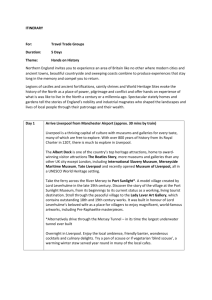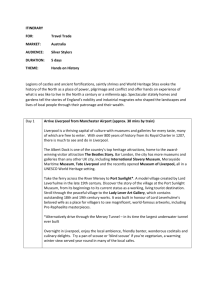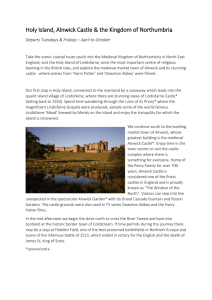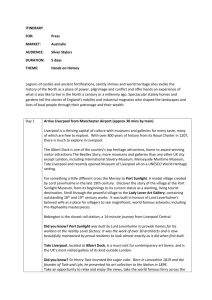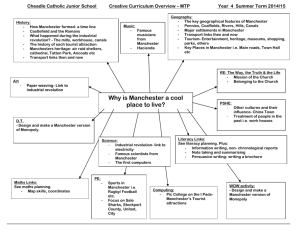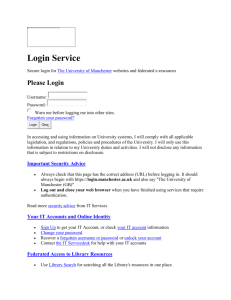7 DAY_Northern highlights (Word, 35KB)
advertisement
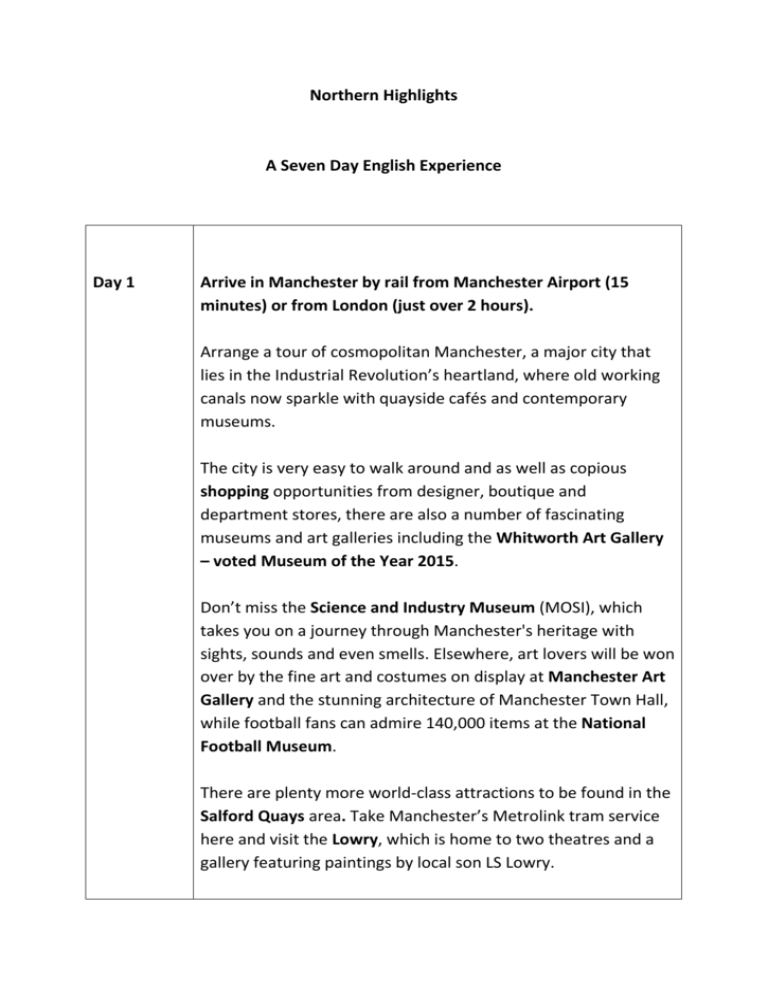
Northern Highlights A Seven Day English Experience Day 1 Arrive in Manchester by rail from Manchester Airport (15 minutes) or from London (just over 2 hours). Arrange a tour of cosmopolitan Manchester, a major city that lies in the Industrial Revolution’s heartland, where old working canals now sparkle with quayside cafés and contemporary museums. The city is very easy to walk around and as well as copious shopping opportunities from designer, boutique and department stores, there are also a number of fascinating museums and art galleries including the Whitworth Art Gallery – voted Museum of the Year 2015. Don’t miss the Science and Industry Museum (MOSI), which takes you on a journey through Manchester's heritage with sights, sounds and even smells. Elsewhere, art lovers will be won over by the fine art and costumes on display at Manchester Art Gallery and the stunning architecture of Manchester Town Hall, while football fans can admire 140,000 items at the National Football Museum. There are plenty more world-class attractions to be found in the Salford Quays area. Take Manchester’s Metrolink tram service here and visit the Lowry, which is home to two theatres and a gallery featuring paintings by local son LS Lowry. History buffs can immerse themselves in insightful exhibitions at nearby Imperial War Museum North and football fans can live out their fantasies on the Manchester United Stadium Tour at Old Trafford. Or if cricket is your passion, head to the Emirates Old Trafford Cricket Ground. Did you know Manchester was the first industrialised city in the world and the first precursor to the modern computer was built in Manchester? Spend the evening taking in a show at the wonderful Bridgewater Hall or Manchester Opera House and pay a visit to China Town where you’ll find an excellent selection of restaurants. Day 2 Travel to the Roman city of Chester for the day by rail (from Piccadilly Station - 1 hour and 20 minutes) or by road (1 hour – via M602/M62/M56 – it is well signposted). Explore Chester on board an open top or heritage bus tour, take a guided walking tour of the city from Chester’s Official Visitor Information Centre, or enjoy a leisurely sail on the River Dee, on one of Chester’s pleasure cruises. Chester has the most complete Roman and medieval city walls in the country – the ideal place for a stroll. It also has the oldest racecourse in England and largest Roman Amphitheatre in Britain, plus a 1000-year-old cathedral. Not to mention the timber-fronted medieval Rows that make for a unique shopping experience, and Chester Zoo - the most visited attraction outside of London. Their latest addition, ISLANDS, recreates the tropical environments of six South East Asian islands. Did you know the Rows are half-timbered galleries, reached by steps, which form a second row of shops above those at street level? They are unique not only in Britain but the world, with some buildings dating back to the 13th century? Day 3 Travel north from Manchester via Preston to Lancaster on M61/ M6, taking 1 hour 30 minutes. The county of Lancashire is famous for its Lancashire Cheese, Lancashire Hotpot, the beautiful Forest of Bowland, the Pendle witches, Lancaster Castle and much more. Lancaster Castle is known as the ‘Queen’s only castle in the north’. It is where the Pendle witches were tried during the reigns of Elizabeth I (1558 - 1603) and James I (1603 - 1625). Nowadays, Lancaster Castle welcomes visitors of all ages for daily tours and special events. Did you know by 1860, Lancashire was providing half of the world’s cotton and textiles via its mills and waterways? Continue north on the M6 to Junction 36/A590 and follow the signs for Levens Hall and Gardens in Cumbria. With over 100 topiary pieces on show, many in the shape of chess pieces, a wander around Levens Hall is like stepping into Alice’s Adventures in Wonderland. The famous topiary gardens were designed by Monsieur Beaumont in 1694 and are the oldest and most extensive in world, with some designs reaching over nine metres high. While you’re here make some time for Levens Hall itself, with its Elizabethan oak panelling and ornate plasterwork. Top Tip: Ask about the ghosts… Day 4 Tour the Lake District National Park by car or take a Mountain Goat (mini coach tour) which gives you the chance to see all of the highlights and get off the beaten track. The glistening lakes and towering mountains of England’s biggest National Park have inspired artists, poets and writers for generations. Key places to visit include The World of Beatrix Potter, which tells the story of Beatrix Potter, the famous children’s author and illustrator and features the characters she created from Peter Rabbit to Jemima Puddle-Duck. Afterwards, climb aboard a Windermere Lake Cruise and explore England’s longest lake. Hop off and on to visit other attractions around the lake or take the 599 bus from St Martin’s Church to the Rydal Mount and Gardens, where 18th century poet William Wordsworth lived for most of his life. Wordsworth wrote his most famous poem, I Wandered Lonely as a Cloud, at the house and also designed the gardens, which remain very much as he left them. Top Tip – Make sure you wear sensible footwear for an hour’s walk from Rydal Mount – which starts at the back of the house – to the village of Grasmere. The route is known as the Coffin Walk, so called as it was the route used to take the dead of Rydal to the church in Grasmere for burial. Once you arrive in Grasmere, take some time to explore the village with its charming shops, tearooms and art galleries as well as the churchyard where William Wordsworth is buried. Next, take a boat onto the waters of Grasmere to get a panoramic view of sweeping fells and shimmering waters, or as Wordsworth described it, ‘the loveliest spot that man hath found’. Don’t leave without trying Sarah Nelson’s Grasmere Gingerbread – the 19th century recipe for this crumbly treat is still top secret. If hidden gems are more your thing, spend the day exploring Coniston Water instead. Another of the National Park’s beautiful lakes, it is home to Brantwood, an idyllic country house and gardens overlooking Coniston Water. It was the home of John Ruskin, a leading English art critic of the Victorian era, from 1872 to 1900. You can reach Coniston Water from Windermere by car via B5286 and A591 or by taking the 505 bus and alighting at Waterhead Hotel. Top Tip: Take the Steam Yacht Gondola to Brantwood from Coniston Pier – just a 10 minute walk away from Waterhead Hotel bus stop. Hungry? Stop by The Bluebird Café first for delicious food and great views of the lake. Did you know Sir Edmund Hillary and Sirdar Tensing ate Kendal Mint Cake on top of Everest in 1953? Tensing also left some to appease his 'gods'. Day 5 Travel north via Ullswater towards Penrith on the A592 – looking back at beautiful views once you’ve climbed up towards Ullswater. Travel from Penrith to Alston on the A686. The AA named the A686 ‘One of the Greatest Drives in Britain’ owing to the dramatic scenery of the Pennines encountered along its route. Continue from Alston – the highest market town in England – onto the A69 following signs for Vindolanda (close to the village of Bardon Mill). The journey will take 2 hours. An extensive Roman museum located on a former ancient fort just south of Hadrian’s Wall, Vindolanda is a live archaeological site with excavations running in the week from April through to September. Excavations aside, the museum is packed full of fascinating Roman artefacts, including Vindolanda’s precious writing tablets – the oldest surviving handwritten documents in Britain. Afterwards, walk along a small part of the National Trail that follows the ruins of Hadrian’s Wall – built during the reign of Emperor Hadrian – to get a sense of its vastness. It stretches for 84 miles from the west coast in Cumbria to east coast in Tyne and Wear. Depart at lunchtime and arrive 1 hour 20 minutes later in Alnwick via A69/A1. Explore Alnwick Castle, built following the Norman Conquest. Set in wonderful grounds, this is the home of the Duke and Duchess of Northumberland and has been in their family for over 700 years. In 2014, the Downton Abbey Christmas Special was filmed here and prior to that two Harry Potter films used Alnwick Castle as Hogwarts. The lavish State Rooms are home to one of the country’s finest private art collections as well as ceramics, furniture and a library containing 14,000 books. Following your visit to Alnwick Castle, take a 5 minute walk to Alnwick Garden. The grand water cascade is the focal point of the garden, but make some time too for the vibrant flowers and plant displays and contemporary water features dotted around the garden. Did you know that the village of Craster, just north of Alnwick, is world famous for its kippers (smoked herring)? They are cured using the original smokehouses dating back 130 years. Also north of Alnwick is Bamburgh Castle, royal seat of the former Kings of Northumbria and one of the most important Anglo Saxon sites in the world. Depart Alnwick and head south via A1/A1M to the city of Durham which takes just over an hour. Day 6 In the morning, head to Durham Cathedral and Castle, a UNESCO World Heritage Site founded in the 11th century. Dominating the city’s skyline, it has starred in Harry Potter films and is one of Europe’s most impressive examples of Romanesque architecture. Grab a late breakfast at the Undercroft Restaurant beneath the cathedral before exploring the city’s winding medieval lanes, admiring the ancient architecture as you stroll. Come midday, take a 15 minute stroll to Crook Hall and Gardens – a Grade-I listed medieval hall surrounded by enchanting gardens. Visitors from all over the world come to share in the timeless magic of Crook Hall and leave inspired by the quintessential English setting. Order afternoon tea in the Georgian Drawing Room and admire views of the Walled Garden and Durham Cathedral in the distance while nibbling on dainty sandwiches and cakes. Depart Durham about 12 noon via A1M south to the city of York (1 and a 1/2 hours) Consider pre-arranging a York Pass which offers discounts from VisitYork via their website. There are over 30 attractions to choose from. For some guidance, here are some ideas… Head to the magnificent York Minster, one of the largest gothic cathedrals in Northern Europe, to admire its tennis court-sized stained glass window, and discover 2000 years of history at the Undercroft – a state-of-the-art attraction housed in chambers beneath the Minster. For unbeatable views, stroll along the ancient city walls and stop off at the 14th century Monk Bar – the tallest of four gatehouses along the walls and home to the Richard lll Experience. Vikings invaded the city more than 1000 years ago and you can experience what life was like back then at Jorvik Viking Centre, discovering the sights, sounds and smells on a journey through a Viking village. Refuel with afternoon tea at the immensely popular Bettys tearoom and don’t forget to try a Yorkshire Fat Rascal – a plump, fruity scone hand-decorated with a glacé cherry and almond face. For a unique shopping experience, head to The Shambles, an impeccably preserved street in the centre of York lined with authentic 14th and 15th century architecture, which today houses an array of shops and boutiques. Close by is Barley Hall, a medieval townhouse once home to the Priors of Nostell and Mayor of York. Come sundown, admire the city’s landmarks from the water on a relaxing boat trip along the River Ouse or get goosebumps as you wander through a maze of cobbled streets on a Ghost Walk which starts from the Kings Arms pub by the river. Day 7 The next morning, visit The National Railway Museum, a free attraction that is home to the UK's national rail collection. Continue your heritage-themed day out by exploring the York Castle Museum and discover the story of York’s social and military past. Alternatively, pop by the Yorkshire Museum to admire Roman and Viking artefacts. Elsewhere, the elegant Treasurer’s House is filled with an extensive array of antique furniture, ceramics, art and textiles, while those with a sweet tooth will love York’s Chocolate Story where you can sample traditional confectionary and get a taste of York’s chocolate-making history. Depart York at 12.30pm and travel south via A1M (towards London), departing at Junction 29 and onto the A617 towards Chesterfield, followed by the A619 towards Bakewell in the Peak District National Park (signposted). Arrive at Chatsworth at 2.15pm. Chatsworth is one of the UK’s most impressive stately homes with vast gardens and parkland rolling as far as the eye can see. Home to the Duke and Duchess of Devonshire, it has been passed down through 16 generations of the Cavendish family, while the house’s elaborate architecture, interiors and one of Europe's most significant art collections have been evolving for five centuries. Spend time exploring Old Masters, contemporary ceramics, Ancient Egyptian artefacts, modern sculpture and much more all in sumptuous stately surroundings. Make time for Chatsworth’s grand greenery too, including the enchanting gardens and famous waterworks such as the 300year-old Cascade, the Squirting Willow Tree Fountain and the impressive gravity-fed Emperor Fountain. Return to Manchester or to London for your onward journey via M1 South.
